Patreon CHORDS 101 Series
Triad Shapes Drills
- Page Six -
Triad Shapes Drills Page Six offers a triad pattern in six keys and six broken chord patterns to play it in.
Download the MS for this module using this link.
The triad pattern
Here's the MS for the pattern in C - the first version.

You start on a C root position triad. Read the voice movement diagrams (VMDs) for the movement.
|
1. The top note moves up. |
2. The middle note moves up. |
3. All the notes move up. |
4. The bottom note moves up. |
Descending, the pattern is as follows.
|
1. All notes move down. |
2. The middle note moves down. |
3. The top note moves down. |
4. The bottom note moves down. |
All moves are one scale-tone only, so the new all-notes-move is pure prallel movement.
The pattern is demonstrated in C, D, E flat, B, B flat and A majors.
Run through this at least two or three times, until your fingering settles down and you're actually choosing the notes and fingers.
Key-specific Keyboards
Remember: You don't have to be able to 'play the scale' to know and select the right black/white keys! Use the key-specific keyboard diagrams to help.
Here are the key-specific keyboards for the keys visited in this module.
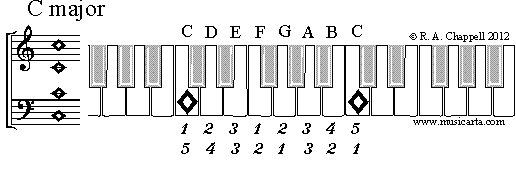 |
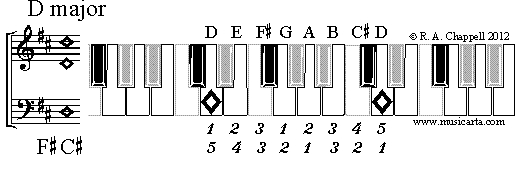 |
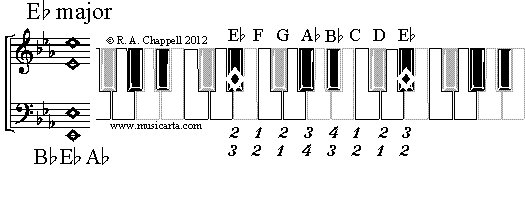 |
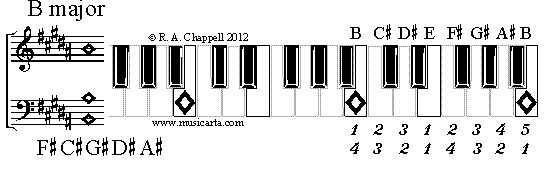 |
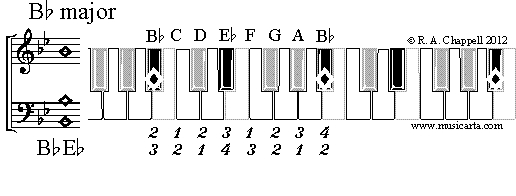 |
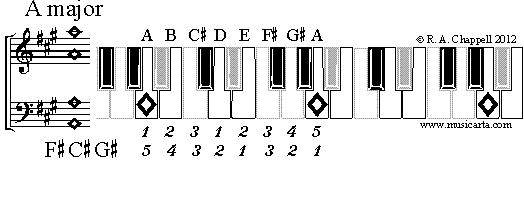 |
The broken chord patterns
Triads in popular music are often played broken up - one note after another.
This is a different proposition to the vertical landing of the all-at-once block chords: the hand has to creep over the uneven territory like a caterpillar. Useful exercise!
This module offers six different broken chord patterns (BCPs). Here's the first one, in C.

The chord tones (the three notes in the chord) are notated B for bottom, M for middle and T for top.
The music shows the first four triads ascending and the last four at the top, and the same descending.
You can see at a glance that the broken chord pattern is BMT ascending and TMB descending.
Here is the second BCP, shown is our second key, D.

This pattern is TMB all the way through.
Notice that the triads are also notated circle for root position, triangle for 1st inversion and square for 2nd inversion - a useful shorthand for understanding and remembering sequences of triads.
Here are all six BCPs demonstrated once each in the six keys we're using.
Combination patterns
Our six keys and six BCP patterns give a total 36 possible combination exercises for you to work through.
If you don't already know your scales, this is a good way to learn what's most important about them - that they are the notes of a key. You can't be a useful contemporary-styles keyboard player without being able to find chords in the sharp/flat keys!
Inexperienced players are often reluctant to get their fingers up towards the back of the keys - the only place you can play many of these triads. It does indeed feel awkward initially, but that it's something to be acknowledged and got over as soon as possible.
|
OUT NOW! |
THE MUSICARTA BEAT & RHYTHM WORKBOOK At last! An effective approach to keyboard rhythm & syncopation skills. Learn more! |
ONLY $24.95! |
PATREON |
The MusicartaA methodical approach to keyboard syncopation for
|
PUBLICATIONS
exciting keyboard
creativity courses
CHORDS 101
WORKBOOK

~HANON~
video course

Musicarta
Patreon
PENTATONICS
WORKBOOK
video course

Creative Keyboard
video course

BEAT AND RHYTHM
WORKBOOK

- Volume 1 -

12-BAR PIANO
STYLES WORKBOOK

MUSICARTA MODES
WORKBOOK

PIANO STYLE

CANON PROJECT
video course

VARIATIONS
video course


- Piano Solo -
video course

- Piano Solo -


YouTube playlists





 THE LOGO
THE LOGO
